61-17974 (SR-71A) Nicknamed "Ichi-Ban",
this aircraft was lost on 21 April 1989 over the South China Sea and is
the last loss of any Blackbird. Pilot Lt Col Dan House, flying at Mach
3+, said the left engine seized (engine compressor bearing froze causing
disintegration)
and shrapnel from the engine hit the right-side hydraulic lines, causing a loss
of flight controls. The pilot descended to 10,000 feet and 400 Kts before
ejecting. House and RSO Blair Bozek ejected and came down safely in the
ocean. They had been able to broadcast their position before abandoning
the Blackbird. They came down 200 yards off the coast of Luzon Island in
the Philippines. The crew were immediately rescued by native fisherman.
Chronology of Events on the Recovery Operation:
The crash scene was off the Northern tip of Luzon Island in the Philippines. The wreckage of #974 rested in 120 feet of water. An Emergency Ordinance Disposal (EOD) and Navy SEAL team was immediately dispatched to the crash scene from Subic Bay NAS in the Philippines. They were to disarm any explosive devices (if needed) and the SEAL's to provide security. Two US Naval vessels, the Frigate USS Ouellet and a Fleet Tug, USS Sioux sped to the scene to provide security. The Recovery vessel USS Beaufort (ATS 2), Commanded by LT CDR Kemp Skudin, was dispatched from Sasebo, Japan to lift the Blackbird from it's watery grave. The Beaufort was fully equipped with a 10 ton crane on the bow and a 16 ton crane on the stern. Divers had the latest equipment, the MK12 Dive system and decompression facilities onboard the ship. Additionally 6 Scuba divers were used. Of more immediate concern were secret components such as surveillance sensors now scattered on the floor of the Babuyan Channel, 250 miles north of Manila. The USS Beaufort, a 280-foot salvage ship arrived on the scene April 29, 1989. Recovery efforts were swift. Sonar operations on April 29 and 30 found the debris field.
April 30 to 1 May: The debris field was mapped.
May 02-04: The sensors; cameras and classified equipment was located. The Mission Recorder was located and brought aboard and then flown to Kadena AB, Okinawa for evaluation of the tapes.
May 02: The left engine was brought aboard the fantail. It showed compressor section damage.
May 04: Found the forward section of the fuselage was broken in half with the nose section folded under the planform (main fuselage).
May 05-06: Weight of the planform was too heavy to be lifted up by the 16 ton crane on the Beaufort's stern.
May 06: A 100,000 pound yard derrick was dispatched to the scene from Subic Bay in the Philippines.
May 07: As the derrick was attempting to lift the planform to the surface, the forward nose section broke off. The nose section was lifted to the stern. All sensors were accounted for and onboard ship.
May 09: The planform was lifted to the stern of the Beaufort.
May 10: The USS Beaufort, with all pieces of the Blackbird accounted for, set course for Okinawa.
These Images were taken as the wreckage was transferred from the USS Beaufort to flat bed trucks in Okinawa for the US Air Force Investigation team's evaluation.
The team was headed up by Chief Investigator, Colonel Al Cirino. The investigation convened in April of 1989. It was determined that materiel failure of a main bearing in the engine caused the shaft to seize. The compressor disintegrated with the flying fragments ripping through the flight control hydraulic lines which caused loss of flight controls. The wreckage was buried at Kadena AB, Okinawa.
It is ironic that the first SR-71 to fly combat missions over Vietnam was also the last Blackbird to crash. The pilot, Lt Col Dan House, said he had no control over the aircraft from Mach 3+ to about Mach 2.5 and the aircraft was like a falling leaf. As aircraft systems continued to shut down, the crew had little alternative but to eject.

Luzon0001a 35.24 Kb |

Luzon0001b 30.44 Kb |

Luzon0001c 32.74 Kb |

Luzon0001d 24.41 Kb |

Luzon0002a 48.28 Kb |

Luzon0002b 28.08 Kb |

Luzon0002c 56.87 Kb |

Luzon0002d 58.23 Kb |

Luzon0003a 61.50 Kb |

Luzon0003b 51.93 Kb |

Luzon0003c 45.23 Kb |

Luzon0003d 29.65 Kb |

Luzon0004a 47.51 Kb |

Luzon0004b 31.20 Kb |

Luzon0004c 49.34 Kb |

Luzon0004d 50.39 Kb |

Luzon0005a 23.13 Kb |

Luzon0005b 43.03 Kb |

Luzon0005c 55.14 Kb |

Luzon0005d 28.24 Kb |

Luzon0006a 36.02 Kb |

Luzon0007a 44.23 Kb |

Luzon0007b 28.97 Kb |
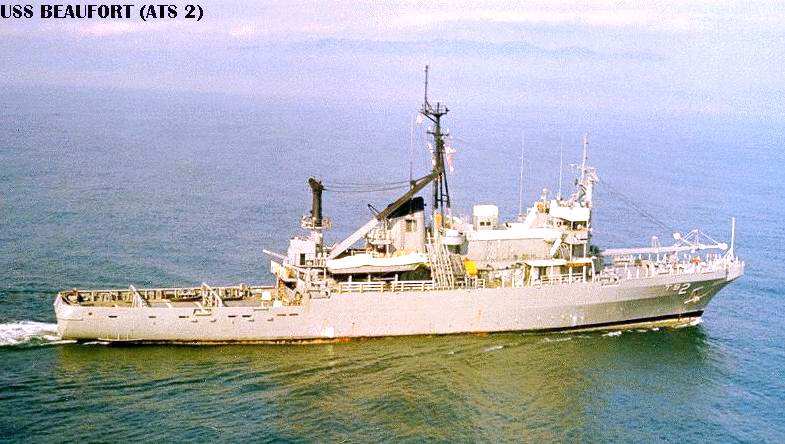
USS Beaufort
Commanded by LT CDR Kemp Skudin
The following six photos of #974 were taken by Matt Moran in Okinawa during the accident investigation.
 Luzon_Moran1.JPG Rudder Section-Luzon #974 |
 Luzon_Moran2.JPG Nose Section-Luzon #974 |
 Luzon_Moran3.JPG Dewars & Oxygen Units-Luzon #974 |
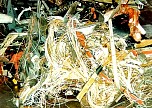 Luzon_Moran4.JPG Wiring-Luzon #974 |
 Luzon_Moran5.JPG Pilot's Cockpit-Luzon #974 |
 Luzon_Moran6.JPG INS Unit-Luzon #974 |
News Articles about the crash appeared in the Stars and Stripes April 23, 1989:
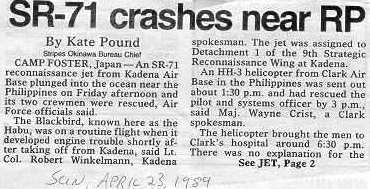
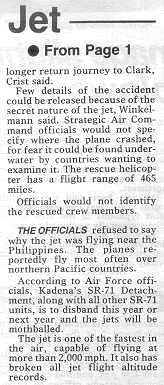
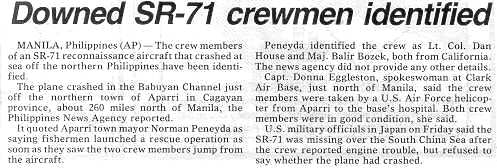
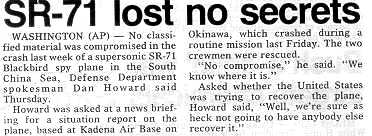
Credits: News Articles and 6 images courtesy of Matt Moran
Posted May 28, 2006
Seaman Mike Sopko recalls the crash recovery operations while serving aboard the USS Beaufort.
He has included an image archive below this article.
Thank you Mike for your contribution:
I was a Seamen onboard the USS Beaufort at the time this happened and here is my is what I remember about picking up the SR-71. We were in Sasebo when we got the call. Our Captain was Commander Gripp, not Skudin (Editors Note: an email from Capt (Ret) USN, Skudin verifys himself as Commander of the USS Beaufort below this article), as it says on the site. I don't remember his first name, sorry. We made the trip to the crash site in three days, mind you it normally took us five days to get to Subic. As I recall, the crash was already located. There was a ship already patrolling the area. I don't remember it's name or what class of ship it was, it was either a frigate or a destroyer. My understanding was it was there to keep the Soviets away, but I can't say for sure because to remember seeing any other ships besides the one. I can also say that there were no shots being fired at us from the beach. I believe the SEAL teams had already secured the area by the time we got there. The rumor was that the plane was running spy missions over China, and that there wasn't suppose to even be an SR-71 in this area of the world. But again, that was a rumor.
We did a three point moor over the crash site. That meant we dropped our two bow anchors and our stern anchor out like the corners of a huge triangle and then positioned ourselves over the site so that we wouldn't drift with the winds or the tides. The only sonar we had, that I'm aware, was a little four foot torpedo sonar that we dragged behind our 28ft work boat. I remember that because I drove the work boat for hours and hours, running the grid to find more wreckage in the debris field. The divers were having a hard time finding the fuselage, and getting the wire rope under the wreckage, and were using fire hoses to blow the sediment out from under it. I believe that's when they discovered that the fuselage broke and landed under the Dwing. When it came time to try and bring the wreckage up with our aft crane. I believe with the weight of the wreckage and the force of the water while lifting caused our ship to tilt and that's why they brought in the derrick. That's about all I remember about picking up the wreckage, most of my time was spent looking for the pilot chairs in the work boat with the torpedo sonar. Which we never found.
Once everything that the divers could collect was onboard, and there was a lot of small debris like the outer skin, we headed to Subic, and then to Okinawa. When we got to Okinawa the Air Force was there with a cherry picker and took it from there. After taking great care in not trying to damage anything as we brought the plane onboard, and being told we were not aloud to take pictures of anything until the Officials got all the cameras and what not from the plane. It was a little frustrating to see them picking the plane up with the crane and letting drop on the pier, which I believe, so the could fit it on the truck. I do have to say that this account is to my best recollection for it's been 17 years since this has happened.
|
|
|
|
||||||||
|
|
|
|
||||||||
|
|
|
|
Credit: Images by Mike Sopko
In an Email received from Captain (Ret.), USN Kemp Skudin on 12/21/2006:
Hi, My name is Kemp Skudin. SN Sopko's input on the salvage of the SR-71 off northern Luzon in May 1989 is wrong in one particular, although the rest is as I recall and the pictures are great. I relieved Jan Gripp in early April 1989 and was the CO of USS BEAUFORT (ATS-2) as a LT CDR during the salvage of the SR-71, not CDR Gripp. The on scene commander during the salvage was LT CDR Jim Wilkins from CTF-73 in Subic. He was in charge of the overall salvage effort for ADM Paul Tobin in Subic while I commanded the ship. Jim and I made the dive where we discovered the fuselage buried under the Delta Planform. Jim noticed the pitot tube from the nose pointing out of the sand and thats how we figured it out. I recall that COL Cirino was a real gentleman and the three of us (COL Cirino, Jim and myself) worked smoothly together and got great support from the CTF-73 staff. Incidently, Jim Wilkins and I both retired this fall as Captains in the DC area. VR, Kemp Skudin
Additional correction: CTF-73 was RADM G. L. Chesbrough....RADM Tobin was RADM Chesbrough's relief. VR, Kemp Skudin
In an Email received from Rick Dillard on Sat, 31 May 2003 21:30
He recalls events of the Luzon crash as follows:
I just read your web-page regarding the crash of the SR-71 off Luzon in 1989. First time I've read anything about this incident since the articles in the Stars and
Stripes shortly after it happened.
At the time, I was with CTF 73 staff in Subic and USS BEAUFORT was under our operational and administrative control. I recall seeing the debris on her fantail
when she tied up about a hundred yards from our headquarters in Subic Bay. I believe this was after locating the main debris field and before arrival of the
salvage barge on-scene and she had come in to refuel/reprovision and await the salvage barge and SEAL Team.
Two things come to mind about this crash. First, I had heard that had the SR-71
crashed a few hundred yards further to seaward, in deeper water, the salvage attempt would not have been made. As it was, she crashed right on the edge of
the continental shelf, in shallow water, and the sensitive equipment had to be
recovered.
Second, the New People's Army had been taking pot shots at the salvage team from the jungles nearby. Before BEAUFORT and the salvage barge returned to the
crash site the SEAL Team in Subic was sent to provide security by conducting patrols along the beach. One of the items from the aircraft that had not been
recovered was the pilot's seat. While conducting a patrol through one of the villages the SEAL Team found the seat in one of the village's nipa huts.
Don't know how much of this was true. It was sometimes difficult to separate fantasy from reality in the Philippines!!! It could be one of the hundreds of
Olongapo City urban legends!!!
Take care,
Rick Dillard
OSCM(SW), USN
Email: Rick Dillard oscmd@hotmail.com
Thanks goes out to everyone who contributed to the accuracy of this webpage.
Leland Haynes, Webmaster, SR-71 Blackbirds
| SR-71 Front Page | Links Page | Index Page | Recollections | 2001 Reunion |
| "SR-71 Blackbirds" Web Site Navigator | ||||
| First Created: April 15, 1996 - Last Revised: March 29, 2004 | ||||
| Copyright © 1996 Leland R. Haynes Email: sr71webmaster@sr71.us | ||||